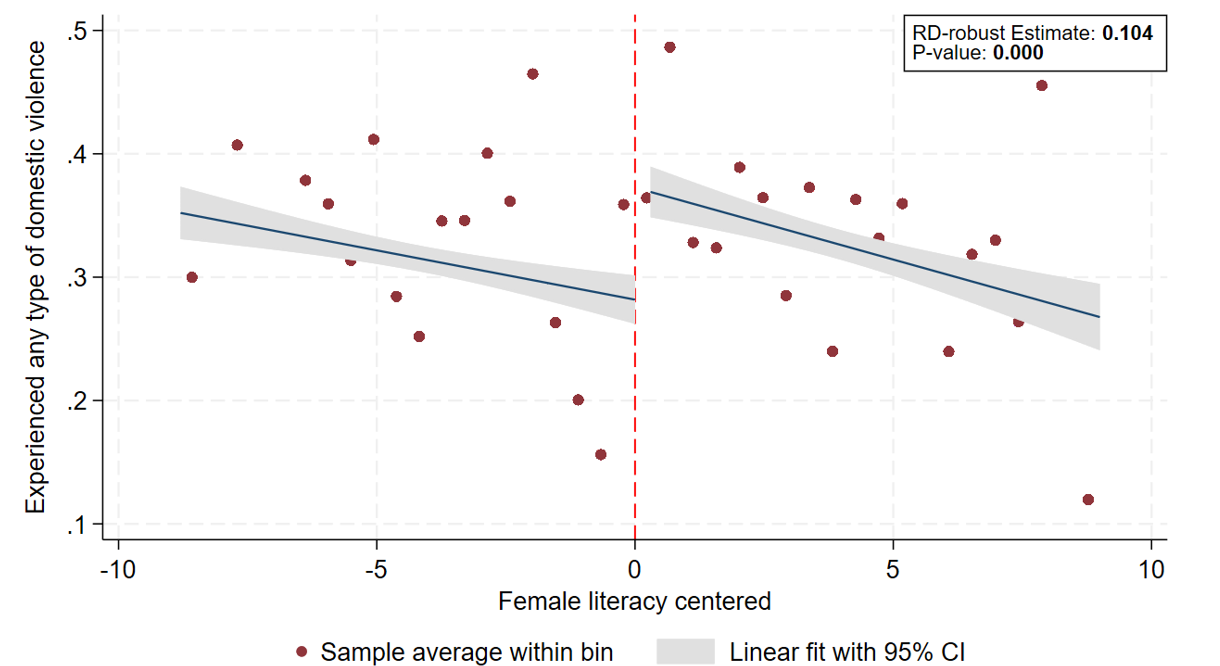Recent global statistics indicate that approximately 27% of women have faced physical or sexual violence from a current or former male partner at least once (World Health Organization (WHO), 2021). This disturbing trend is mirrored in India, where nearly one-third of women between the ages of 15 and 49 report experiencing domestic violence (International Institute for Population Sciences (IIPS) and ICF, 2020). Domestic violence has a damaging personal impact and creates significant barriers to women's independence in both private and public spheres (Rana et al. 2023). It impairs women's health, educational outcomes, and economic potential, ultimately restricting the development of society's human capital (Aizer 2011, Campbell 2002, Huth-Bocks et al. 2001, Koenen et al. 2003).
In line with the United Nations Sustainable Development Goals, there is an urgent need to recognise the widespread harm and violation of human rights, and eradicate violence against women and girls. In this context, in Agarwal et al. (2024), we investigate the long-term impact of education reforms targeted towards girls of school-going age on domestic violence later in their adulthood.1
Data and methodology
Understanding the direct effect of education on domestic violence is difficult because other factors, such as family wealth or beliefs about gender, can influence both a woman's education level and the risk of experiencing violence. For example, consider a woman from a wealthier family, who can easily access education. It might be her family's wealth, rather than her education, which offers protection from abuse. If we could randomly increase the education level of some women, we could untangle or isolate its effect on domestic violence, regardless of other factors such as family background or beliefs.
To do so, we leverage a unique large-scale education expansion programme in India. Launched in 1994, the District Primary Education Programme (DPEP) built approximately 160,000 new schools in areas with low female literacy rates (below the 1991 national average of 39.3%). This programme acts like a natural experiment, allowing us to compare outcomes for women who barely missed being eligible for a new school (due to living in a slightly higher literacy district) to those who narrowly crossed the threshold to gain access to one. This research approach, called regression discontinuity design (RDD), helps us isolate the effect of the intervention (more schools) on domestic violence by minimising the influence of other confounding factors, such as family income or pre-existing attitudes towards violence. This approach gives us a ‘as if random’ assignment of the intervention in the close neighbourhood of (that is, just above or below) the eligibility criteria, as the slight difference in literacy does not significantly influence other factors that might affect domestic violence.
The outcome – prevalence of domestic violence – is measured based on self-reported experiences of various forms of abuse by women from the Demographic and Health Survey (2015-16).
Findings
Figure 1 visually depicts the relationship between DPEP and domestic violence.
Figure 1. Impact of DPEP on domestic violence

Notes: (i) The plot illustrates a regression discontinuity design analysis of the relationship between DPEP eligibility criteria (District female literacy below 39.3%) and the incidence of domestic violence. (ii) The horizontal axis represents female literacy rates centred around a threshold (indicated by the red dotted line), and within a range of +/-10 percentage points. Those below the threshold to the left of dotted line were eligible for DPEP and those to the right were not. (iii) The vertical measures reported instances of domestic violence. (iv) A 95% confidence interval (CI) is a way of expressing uncertainty about estimated effects. Specifically, it means that if you were to repeat the experiment over and over with new samples, 95% of the time the calculated confidence interval would contain the true effect.
A clear downward shift in the line is observed at the eligibility threshold (the vertical red dotted line). The data points, representing sample averages within each ‘bin’, show a break in trend; for districts on the left of the female literacy threshold, which are eligible for DPEP, the incidence of domestic violence decreases compared to those on the right. Specifically, women in programme-eligible districts experienced a 10 percentage point reduction in instances of domestic violence compared to those in non-eligible districts.2 Using the eligibility indicator as an instrument for the school expansion programme, we estimate its effect on women who actually received the programme ‘Local Average Treatment Effect’ or using a ‘fuzzy RDD’.3 We find that the programme leads to a 32 percentage point overall reduction in any type of violence – including a 13 percentage point decrease in emotional abuse, 26 percentage point decrease in less severe physical violence, 9 percentage point decline in sexual violence, and 10 percentage point reduction in violence-related injuries.
Mechanisms
Our results shows that this large-scale school expansion programme led to a significant decrease in domestic violence. But how? To make our findings relevant and useful for policy, we need to further dissect the pathways that explain these results.
Remarkably, while the programme boosted women's educational attainment by almost one year, it did not lead to greater female participation in the workforce or increased income. This aligns with a puzzling trend in India: educational gains have not translated into better economic opportunities for women over the past 20 years (see, for instance, Klasen and Pieters (2015) and Jayachandran (2021)). Furthermore, we did not find any changes in women's decision-making power in their households. This tells us that traditional economic explanations might not fully account for how education combats domestic violence.
Given these findings, we examine the impact of education on gender attitudes and beliefs. Women’s beliefs in gender equality and less tolerance toward domestic violence can lead to a higher likelihood of retaliation; hence, making domestic violence costlier in terms of social acceptance and legal consequences. We find that for more educated women, there is a 28 percentage point decrease in justifying violence for going out and neglecting children. There is a 19 and 35 percentage point fall in justifying violence for being unfaithful and disrespectful, respectively. Overall, educated women show significant improvements in gender attitudes, with less acceptance of violence. Next, we explore partner quality by looking at certain characteristics of women’s partners. We find significant differences in the gender attitudes of partners between educated and less-educated women. Partners of educated women are less likely to justify domestic violence, which can contribute to a less violence-prone environment within the relationship. Moreover, educated women tend to marry wealthier partners, which could also alleviate financial tensions and thereby reduce domestic conflicts (see Haushofer et al. (2019) for findings in other country contexts).
Finally, we examine how education influences women's access to information. More educated women are 17 percentage points more likely to engage with newspapers and 13 percentage points more inclined to use mobile text messages than their less-educated counterparts. Additionally, there is evidence that women in treated districts are more proactive in seeking help from formal institutions, suggesting that education empowers them with the knowledge and resources to challenge domestic violence.
Policy implications
Our research indicates that education can serve as a useful policy tool for reducing domestic violence against women. This reduction is mainly linked to positive shifts in the gender attitudes of women, the quality of partners, and an increase in accessing information, which empowers women to actively seek help. We find that these factors are more influential, as education is not seen to translate to significant changes in women's economic status or authority in household decisions.
The study highlights the important role of education in altering perceptions regarding gender beliefs and attitude toward domestic violence, thereby making the act of violence costlier in terms of social acceptance and legal consequences. The findings advocate for policies that focus on transforming gender beliefs and attitudes of both women and men, as these could play a critical role in combating gender-based violence.
Education can also open information channels and provide women with tools to combat violence. However, our understanding of how educational advancements guide the decision to report domestic violence is still nascent because of data limitations. Future research should delve into how education influences the propensity to report domestic violence to formal authorities. Enhancing reporting rates could be a key strategy in the broader fight against the prevalence of domestic violence.
Notes:
- It is important to note that women’s migration for marriage is common practice. However, a significant proportion of women, about 73%, stay within their birth district throughout their lives (Beauchamp et al. 2023). This suggests that the educational benefits from the DPEP likely remain relevant to a substantial majority of women living in areas with low female literacy rates.
- These are reduced-form estimates or ‘Intention-to-treat’ (ITT) effects where we use the female literacy cut-off indicator as a proxy for the programme. This measures the effect of being offered a ‘treatment’, not necessarily taking it.
- A fuzzy RDD measures the effect of the programme on those who actually take-up the treatment (more schooling) because they are eligible. In this case, LATE would only look at the women in district who were eligible and received the intervention, comparing them to a similar group who were not eligible for the programme.
Further Reading
- Aizer, Anna (2010), “The Gender Wage Gap and Domestic Violence”, American Economic Review, 100(4): 1847-1859.
- Agarwal, M, V Bahure, K Bergonzoli and S Maji (2024), ‘Education and Domestic Violence: Evidence from a School Construction Program in India’, Working Paper. Available here.
- Campbell, Jacquelyn C (2002), “Health consequences of intimate partner violence”, The Lancet, 359(9314): 1331-1336.
- Huth-Bocks, Alissa C, Alytia A Levendosky and Michael A Semel (2001), “The Direct and Indirect Effects of Domestic Violence on Young Children’s Intellectual Functioning”, Journal of Family Violence, 16: 269-290.
- Koenen, Karestan C, Terrie E Moffitt, Avshalom Caspi, Alan Taylor and Shaun Purcell (2003), “Domestic violence is associated with environmental suppression of IQ in young children”, Development and Psychopathology, 15(2): 297-311.
- International Institute for Population Sciences and ICF (2020), ‘National Family Health Survey (NFHS-5), 2019-20: India Report’. Available here.
- Jayachandran, Seema (2021), “Social Norms as a Barrier to Women’s Employment in Developing Countries”, IMF Economic Review, 69(3): 576-595.
- Klasen, Stephen and Janneke Pieters (2015), “What explains the stagnation of female labor force participation in urban India?” The World Bank Economic Review, 29(3): 449-478
- Haushofer, J, C Ringdal, JP Shapiro and XY Wang (2019), “Income Changes and Intimate Partner Violence: Evidence from Unconditional Cash Transfers in Kenya”, NBER Working Paper 25627.
- Rana, T, R Shukla and A Kapur (2023), ‘Where Do the Victims of Gender-Based Violence go? A Needs Analysis for Women’s Safety Schemes in India’, Policy Report, Accountability Initiative, Centre for Policy Research.
- World Health Organization (2021), ‘Violence Against Women Prevalence Estimates, 2018’, Global Health Report.




 10 April, 2024
10 April, 2024 







Comments will be held for moderation. Your contact information will not be made public.